If you want to know about the staircase design or landscape garden or requirements for disabled persons in a building, please click the link.
Introduction
Deconstructivist architecture is a style of contemporary architecture that challenges traditional notions of form and function by breaking down architectural elements and reassembling them in unconventional ways.
It emerged as a movement in the 1980s and was associated with architects such as Zaha Hadid, Frank Gehry, and Rem Koolhaas, among others.
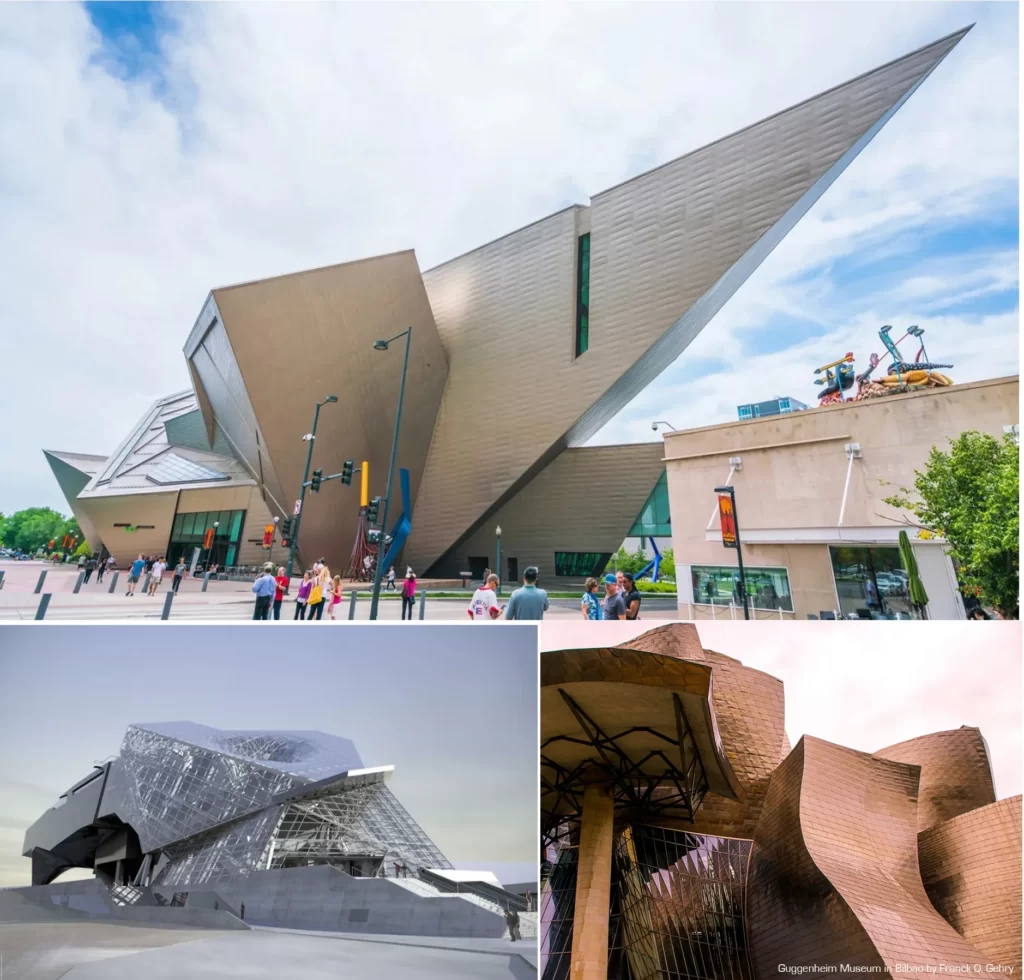
This article will provide an overview of deconstructivist architecture, discussing its key characteristics, historical context, philosophical influences, global presence, criticisms, and contemporary developments. It will explore how deconstructivist architecture has challenged and expanded the boundaries of traditional architecture, and how it continues to influence contemporary architecture.
1) Characteristics of Deconstructivist Architecture
Deconstructivist architecture sets itself apart from other architectural styles through its deliberate fragmentation and distortion of architectural elements. It challenges traditional notions of form and function by breaking down and reassembling architectural elements in unconventional ways.
The key characteristics of deconstructivist architecture include:
- Fragmentation: Deconstructivist architecture often incorporates fragmentation or the breaking down of architectural elements into smaller parts. These fragments are then arranged in unconventional ways to create a new and unique form.
- Asymmetry: The use of asymmetrical shapes and designs is a common characteristic of deconstructivist architecture. The buildings may appear unbalanced or uneven, challenging traditional notions of symmetry and balance.
- Unconventional shapes and materials: Deconstructivist architecture often incorporates non-traditional shapes and materials, such as curved or angled walls, irregularly shaped windows, and unconventional building materials like titanium, concrete, and steel.
Some examples of deconstructivist buildings include:
- Guggenheim Museum Bilbao by Frank Gehry: This building is known for its strikingly asymmetrical design and the use of titanium panels to create an irregular, fragmented facade.
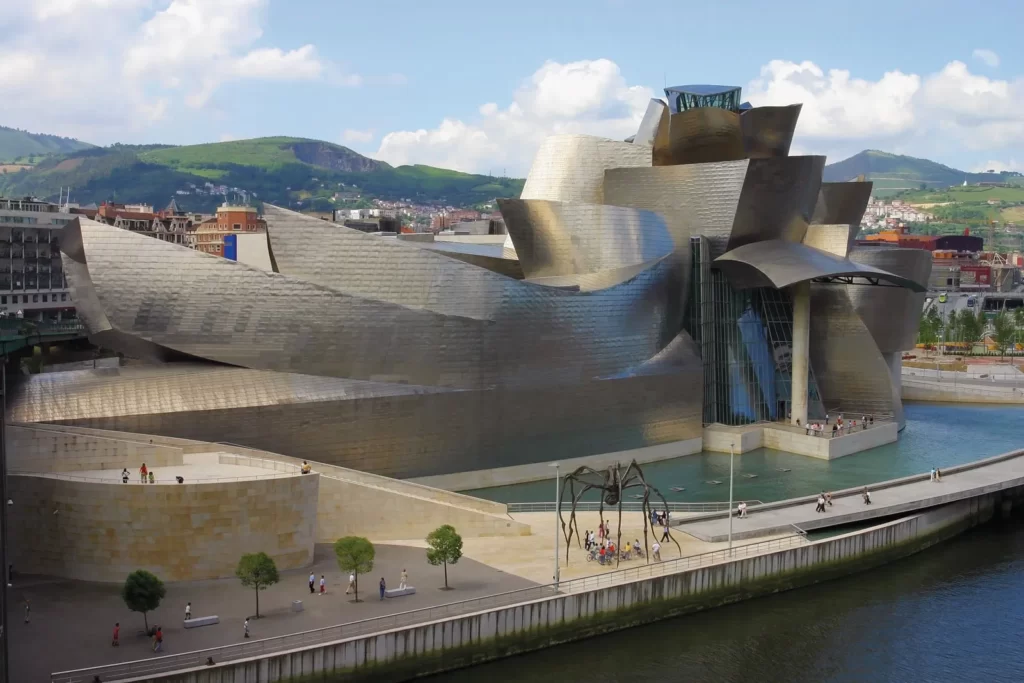
- Walt Disney Concert Hall by Frank Gehry: The building features a unique, asymmetrical design that incorporates curving, metallic forms and is covered in stainless steel panels.

- Vitra Design Museum by Frank Gehry: This building is characterized by its fragmented, asymmetrical design and the use of unconventional materials such as white plaster, zinc, and aluminum.

- MAXXI National Museum of 21st Century Arts by Zaha Hadid: This building features a complex, asymmetrical design that incorporates sweeping curves and fragmented shapes to create a unique and dynamic form.
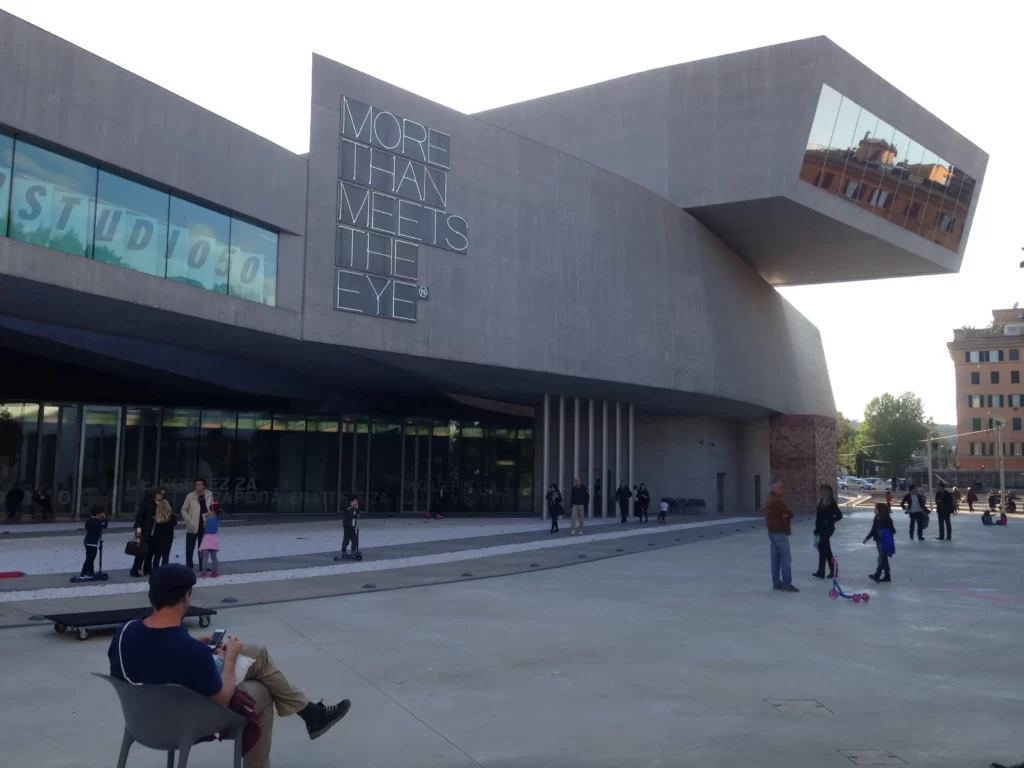
These buildings demonstrate the key characteristics of deconstructivist architecture, such as fragmentation, asymmetry, and the use of unconventional shapes and materials. They challenge traditional notions of form and function and create dynamic, visually striking structures.
2) Historical Context of Deconstructivist Architecture
Deconstructivist architecture emerged in the late 20th century as a response to the dominant modernist architecture of the mid-century. It arose during a period of cultural and political upheaval in the Western world, marked by the rise of postmodernism, the avant-garde, and the increasing importance of theory in the arts and humanities.
The movement was influenced by postmodernism, which challenged the principles of modernist architecture and embraced a more eclectic, playful, and historically referential approach to design. The avant-garde also played a role in the development of deconstructivist architecture, with its emphasis on experimentation, innovation, and subversion of established norms and conventions.
Deconstructivist architecture challenged traditional notions of form and function by breaking down and fragmenting architectural elements, and reassembling them in unconventional ways. This approach rejected the functionalist ethos of modernist architecture, which prioritized efficiency, simplicity, and clarity, in favor of a more expressive, complex, and dynamic approach.
The movement was characterized by a focus on form over function, and an interest in the expressive potential of architectural elements. Architects associated with the movement sought to challenge established architectural norms, experiment with new materials and technologies, and create buildings that were more expressive, dynamic, and evocative.
Overall, deconstructivist architecture represented a radical departure from the established norms of modernist architecture, and a rejection of its functionalist ethos. It challenged traditional notions of form and function, and sought to create buildings that were more expressive, dynamic, and visually striking.
3) The Influence of Philosophy on Deconstructivist Architecture
Philosophy has played a significant role in the development of deconstructivist architecture. Many architects associated with the movement were influenced by the ideas of philosophers such as Jacques Derrida and Martin Heidegger, who advocated for a critical and subversive approach to established norms and conventions.
Jacques Derrida’s philosophy of deconstruction was particularly influential on deconstructivist architecture. Deconstruction challenged the idea of a fixed, stable meaning or essence in language, and instead emphasized the fluidity, ambiguity, and instability of meaning.
Architects associated with deconstructivism sought to apply these ideas to architecture, by breaking down and reassembling architectural elements in unconventional and surprising ways. This approach rejected the idea of a fixed or stable architectural form, and instead emphasized the dynamic, fluid nature of architectural meaning and expression.
Martin Heidegger’s philosophy of Being and Time also influenced deconstructivist architecture. Heidegger’s ideas about the relationship between human beings and their environment, and his emphasis on the importance of the existential experience of space and place, resonated with architects interested in creating buildings that were more expressive and responsive to their context.
Some examples of buildings that demonstrate the influence of philosophy on deconstructivist architecture include:
- Jewish Museum Berlin by Daniel Libeskind: This building is characterized by its fragmented, asymmetrical design, which reflects the fragmentation of Jewish history and culture. It incorporates empty spaces and sharp angles to create a sense of disorientation and uncertainty, in keeping with Derrida’s ideas about the instability of meaning.

- Sendai Mediatheque by Toyo Ito: This building features a complex, fluid design that emphasizes the experiential nature of space and place. Its use of open spaces, fluid lines, and unconventional shapes reflects Heidegger’s emphasis on the importance of the existential experience of architecture.
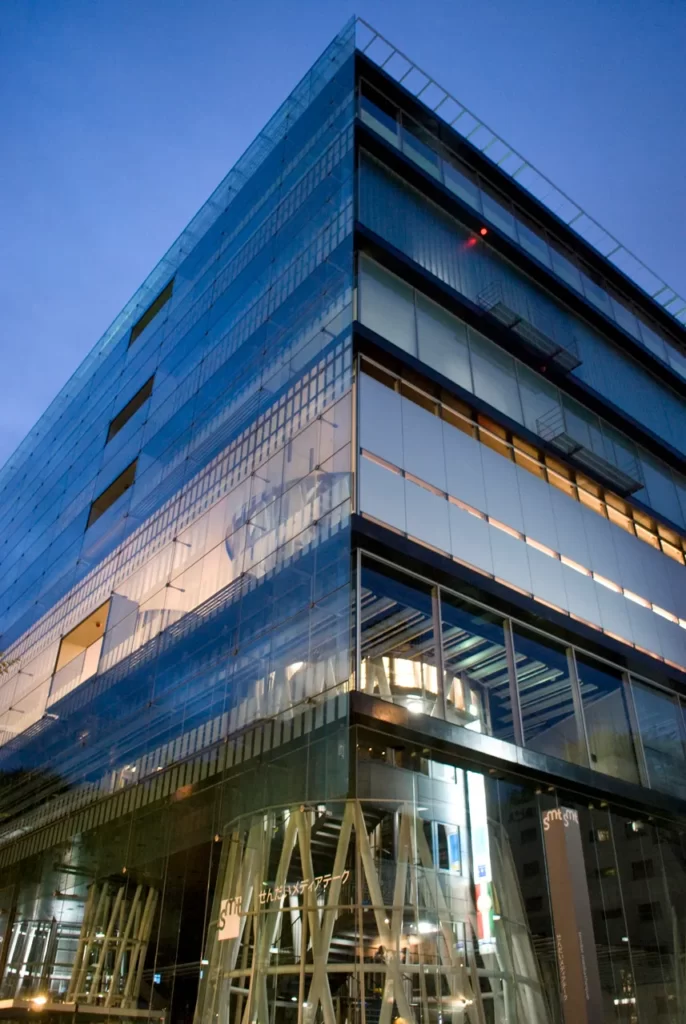
- CCTV Headquarters by Rem Koolhaas: This building features a strikingly asymmetrical design that challenges traditional notions of form and function. Its use of unconventional shapes and materials, such as its two towers connected by a cantilevered section, reflects the influence of Derrida’s philosophy of deconstruction.

These buildings demonstrate the influence of philosophy on deconstructivist architecture, and reflect the movement’s interest in creating buildings that were more expressive, dynamic, and responsive to their context.
It is important to note that deconstructivist architecture is not a homogeneous movement, and there are many different approaches and interpretations of its principles.
Nonetheless, it is clear that philosophy has played a significant role in shaping the ideas and practices of deconstructivist architects, and that their work reflects a critical and subversive attitude towards established norms and conventions.
4) Deconstructivist Architecture Around the World
Deconstructivist architecture has spread around the world since its emergence in the 1980s and has become a global movement that has been embraced by architects from different regions and cultures. One of the reasons for its global spread is the movement’s rejection of traditional architectural styles and the emphasis on the fluidity, dynamism, and expressiveness of architectural forms, which resonated with architects and clients seeking to break away from the past.
The spread of deconstructivist architecture can also be attributed to globalization, the increased mobility of architects, the rise of international competitions, and the availability of digital design tools that facilitate the exploration of complex and unconventional forms. Additionally, the movement’s intellectual and aesthetic roots in philosophy, literature, and the arts have contributed to its international appeal and transcultural relevance.
Examples of deconstructivist buildings from different countries and regions include:
- Guggenheim Museum Bilbao, Spain, designed by Frank Gehry: This iconic building is characterized by its undulating titanium exterior, which reflects the surrounding landscape and the city’s industrial history.

- Guangzhou Opera House, China, designed by Zaha Hadid: This building features a fluid, organic design that reflects the city’s dynamic growth and its cultural heritage.
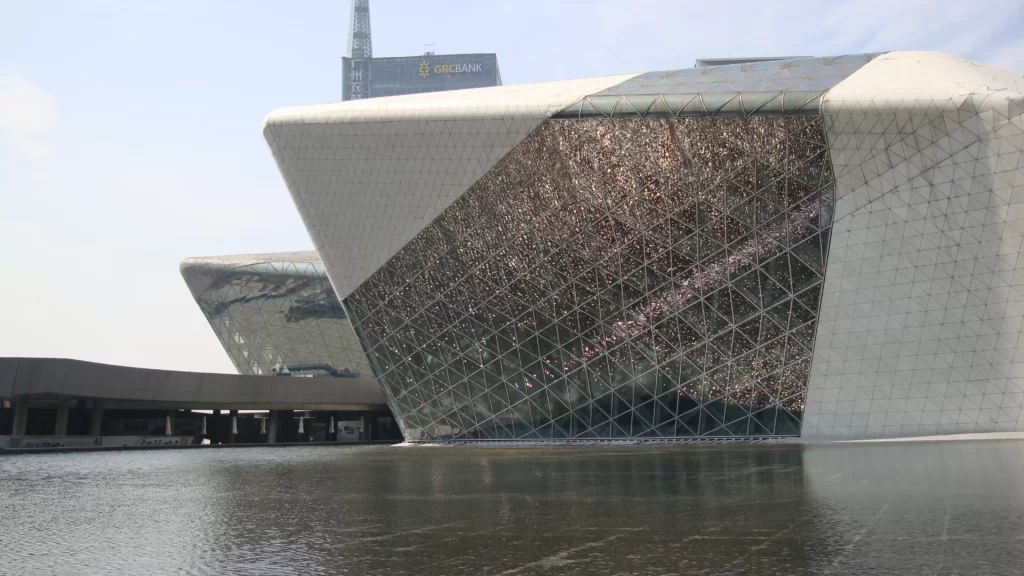
- 30 St Mary Axe (The Gherkin), UK, designed by Norman Foster: This building’s distinctive shape and glazing system make it stand out in London’s skyline, and its energy-efficient features reflect the city’s commitment to sustainability.
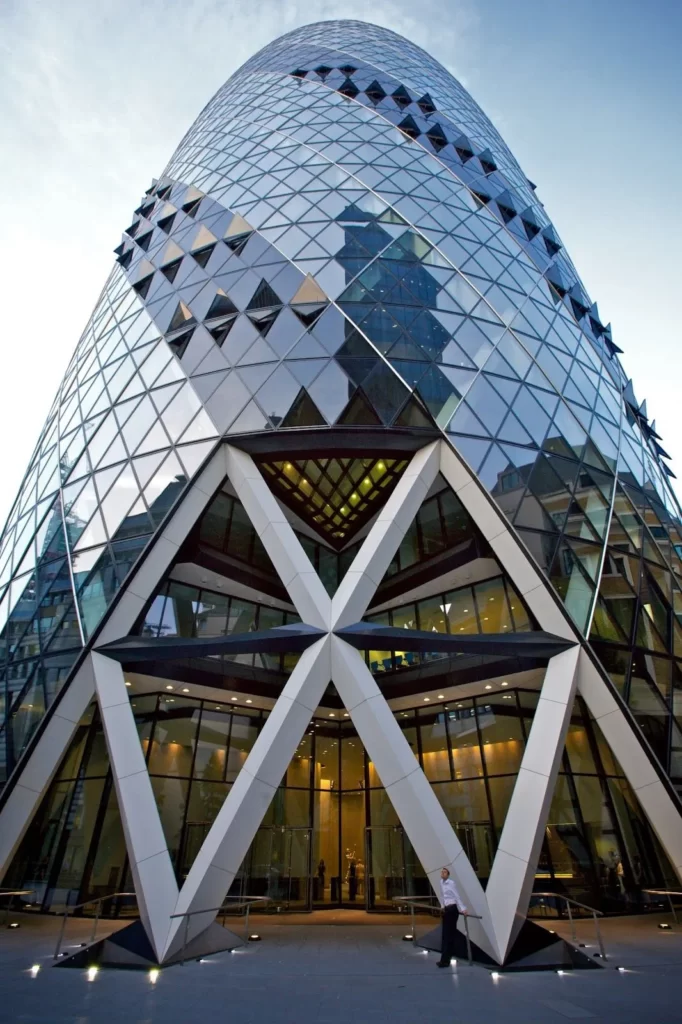
- Burj Khalifa, UAE, designed by Skidmore, Owings & Merrill: This building is the world’s tallest skyscraper and features a tapered shape and a triangular plan that reflects the desert landscape and the Islamic architectural tradition.
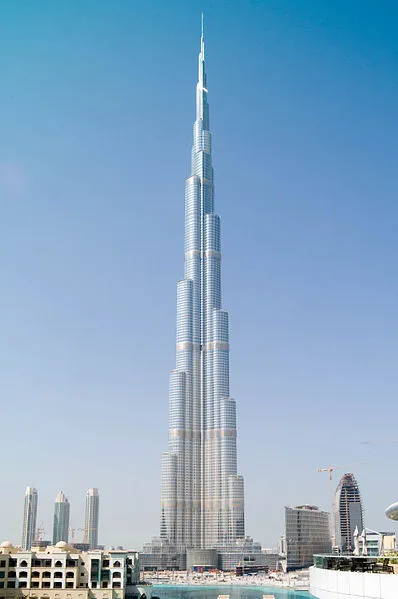
- Jewish Museum Berlin, Germany, designed by Daniel Libeskind: This building’s fragmented and asymmetrical design reflects the Jewish history and culture and challenges the traditional notions of architectural form and function.

The development of deconstructivist architecture in different places has been influenced by local culture, geography, climate, and history. For example, in China, deconstructivist architecture has been embraced as a means of expressing the country’s modernity and its cultural heritage, as well as its rapid urbanization and globalization.
In contrast, in Europe, deconstructivist architecture has been associated with a critical attitude towards history and tradition and has been used to challenge the dominance of classical and neo-classical styles.
In regions with extreme climates, such as the Middle East, deconstructivist architecture has been used to explore innovative and sustainable solutions to the challenges of heat and sunlight. In Latin America, deconstructivist architecture has been used to express the region’s social and political struggles and to reflect its diverse cultural heritage and natural landscapes.
In summary, deconstructivist architecture has spread around the world and has been embraced by architects from different regions and cultures. The movement’s rejection of traditional architectural styles, its emphasis on the fluidity, dynamism, and expressiveness of architectural forms, and its intellectual and aesthetic roots in philosophy, literature, and the arts have contributed to its international appeal and transcultural relevance.
The development of deconstructivist architecture in different places has been influenced by local culture, geography, climate, and history, and has reflected the region’s unique context and identity.
5) Criticisms of Deconstructivist Architecture
Criticism of deconstructivist architecture has been around since its emergence in the 1980s.
Some of the criticisms that have been leveled against it include:
- Lack of Functionality: One of the criticisms of deconstructivist architecture is that it focuses too much on form and not enough on function. Some critics argue that deconstructivist buildings are difficult to navigate and lack practicality, leading to a disconnect between the building’s form and its purpose.
- Cost: Another criticism of deconstructivist architecture is that it is expensive to construct and maintain. The complex and unconventional forms require specialized engineering, construction techniques, and materials, which can drive up costs.
- Aesthetic Controversy: Some people find deconstructivist architecture controversial or difficult to understand because it challenges traditional notions of architectural form and function. The style often features fragmented, asymmetrical designs that can be disorienting or unsettling to some viewers.
- Lack of Contextual Sensitivity: Critics argue that deconstructivist buildings often lack sensitivity to their context and surroundings. The unconventional forms can clash with the surrounding built environment and natural landscape, leading to a sense of discord.
Counterarguments to these criticisms include:
- Functionality: While it is true that some deconstructivist buildings prioritize form over function, this is not inherent to the style. Many deconstructivist buildings are designed with the user in mind and incorporate practical features such as efficient circulation, accessible spaces, and ample daylighting.
- Cost: While deconstructivist buildings may be more expensive to construct and maintain than traditional buildings, the investment can pay off in the long run. Many deconstructivist buildings are energy-efficient and sustainable, which can result in lower operating costs and a reduced environmental footprint.
- Aesthetic Controversy: While some people may find deconstructivist buildings difficult to understand or controversial, this is not necessarily a flaw. Like all art, architecture should provoke thought and challenge preconceived notions. The disorienting or unsettling effects of deconstructivist architecture can be intentional, designed to disrupt the viewer’s expectations and create a sense of dynamism.
- Contextual Sensitivity: While it is true that some deconstructivist buildings may clash with their surroundings, this is not inherent to the style. Many deconstructivist architects are sensitive to the context and strive to create buildings that harmonize with their surroundings. Additionally, deconstructivist buildings can be used to reinvigorate or transform neglected or underutilized urban spaces.
In conclusion, while deconstructivist architecture has faced criticism, it is important to recognize that like any architectural style, it has its strengths and weaknesses. By balancing form and function, cost and sustainability, and aesthetic expression and contextual sensitivity, deconstructivist architecture can create buildings that are both striking and functional.
6) Deconstructivist Architecture Today
Deconstructivist architecture has evolved since the 1980s, both in terms of its aesthetic language and its conceptual underpinnings. While the movement’s early buildings were often characterized by dramatic, angular forms and fragmented geometries, contemporary deconstructivist architecture has become more diverse and sophisticated, incorporating new technologies, materials, and approaches to sustainability.
One way in which contemporary architects are incorporating deconstructivist ideas into their work is by using digital tools to generate complex and unconventional geometries. For example, architects are using parametric design software to create buildings with intricate, non-repeating forms that respond to site-specific constraints and environmental factors.
Additionally, advances in fabrication technologies, such as 3D printing and robotic construction, are enabling architects to realize increasingly complex and precise geometries in their built work.
Another way in which contemporary architects are incorporating deconstructivist ideas into their work is by exploring the expressive potential of materials and construction techniques.
For example, architects are using materials such as glass, steel, and concrete in unconventional ways, creating buildings that appear to defy gravity and challenge our perceptions of materiality. Additionally, architects are exploring new approaches to construction, such as modular and prefabricated systems, that allow for greater flexibility and adaptability in the design process.
Examples of recent deconstructivist buildings include:
- Beijing Daxing International Airport, China, designed by Zaha Hadid Architects: This airport features a striking, flowing roof structure that spans over 1 million square meters and is inspired by the shape of a phoenix.

- Louvre Abu Dhabi, UAE, designed by Jean Nouvel: This museum features a complex, layered design that incorporates water, light, and shade to create a sensory experience that evokes the ancient Arab medina and the traditional souk.
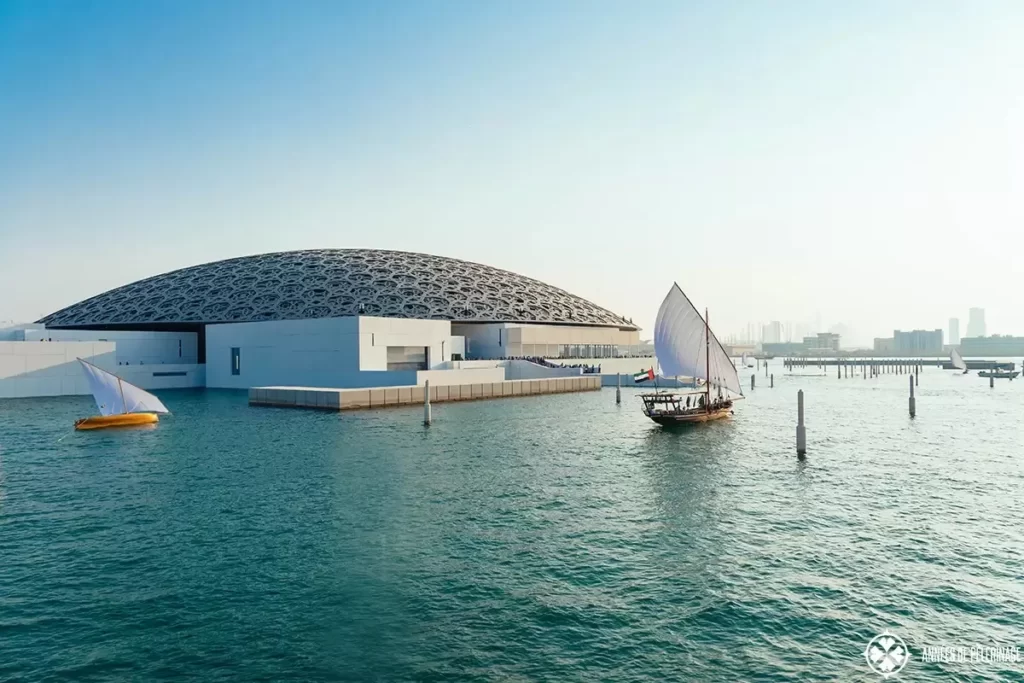
- Oodi Central Library, Finland, designed by ALA Architects: This library features a dynamic, multi-level interior space that is defined by a sweeping, curving form and an abundance of natural light.
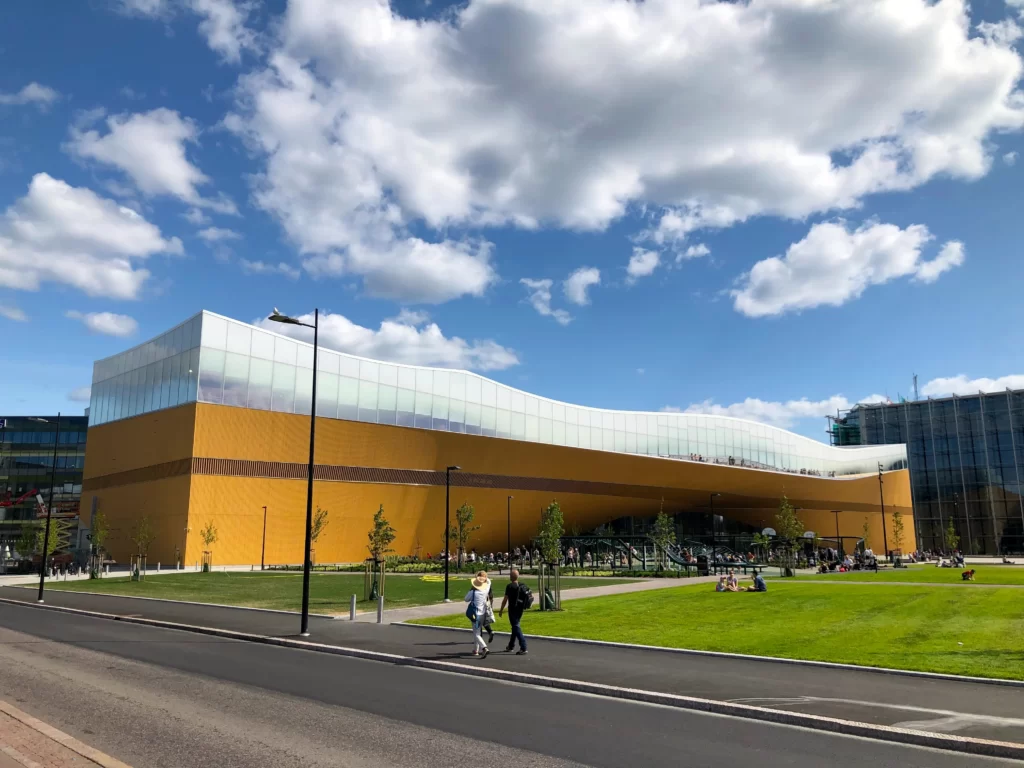
- Chaoyang Park Plaza, China, designed by MAD Architects: This mixed-use development features a pair of striking, twisting towers that appear to defy gravity and create a sense of fluidity and movement.
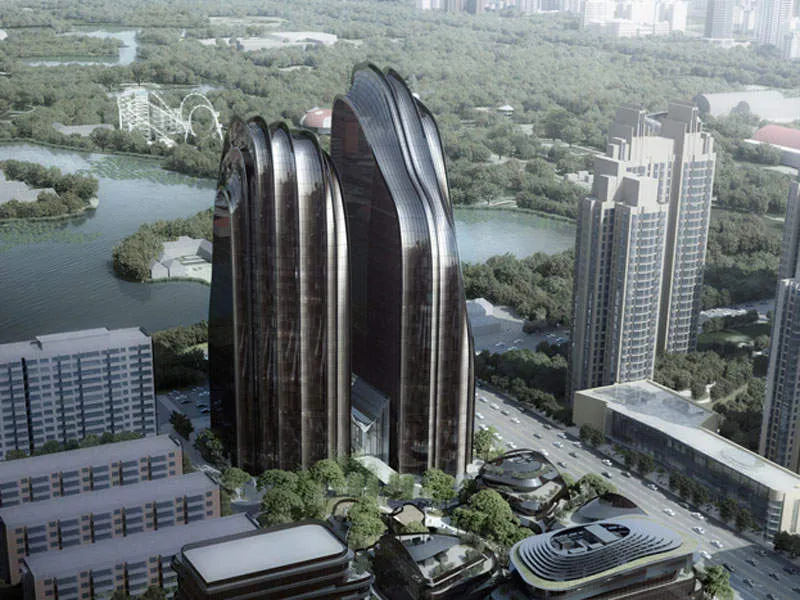
- The Shed, USA, designed by Diller Scofidio + Renfro: This cultural center in New York City features a dynamic, movable shell that can be expanded or contracted to accommodate a wide range of performances and events.

In summary, deconstructivist architecture has evolved since the 1980s, incorporating new technologies, materials, and approaches to sustainability.
Contemporary architects are incorporating deconstructivist ideas into their work by using digital tools to generate complex and unconventional geometries, exploring the expressive potential of materials and construction techniques, and creating buildings that respond to site-specific constraints and environmental factors.
Recent examples of deconstructivist buildings demonstrate the ongoing relevance and vitality of this architectural style.
7) Conclusion
Deconstructivist architecture is a movement that emerged in the 1980s and has spread worldwide. It is characterized by fluid, dynamic, and expressive forms that reject traditional architectural styles. The movement’s international appeal is due in part to its intellectual and aesthetic roots in philosophy, literature, and the arts, as well as globalization, increased mobility of architects, and availability of digital design tools.
Critics of deconstructivist architecture argue that its forms are arbitrary, that it ignores the function of buildings, and that it is unsustainable. However, supporters counter that its forms are not arbitrary, but rather a reflection of cultural, historical, and environmental factors, and that it allows for new approaches to sustainable design.
Since its emergence, deconstructivist architecture has evolved to incorporate new technologies and materials, as well as social and environmental considerations. Contemporary architects continue to incorporate deconstructivist ideas into their work, such as exploring unconventional forms and materials, challenging traditional notions of function and program, and using digital design tools to facilitate experimentation.
Recent examples of deconstructivist buildings include the Beijing Daxing International Airport in China, designed by Zaha Hadid Architects, which features a fluid, organic form that responds to the site’s topography and the airport’s complex program; and the La Samaritaine Department Store in Paris, designed by SANAA, which uses glass and steel to create a layered, transparent façade that reflects the building’s historical context while also providing energy efficiency through natural light and ventilation.

Overall, deconstructivist architecture has had a significant impact on contemporary architecture and design, challenging traditional notions of form, function, and sustainability. While it may not be universally embraced, it has undoubtedly opened up new possibilities for architectural expression and experimentation.